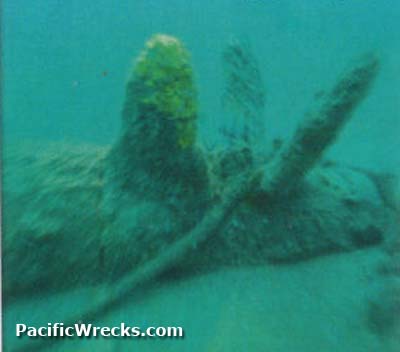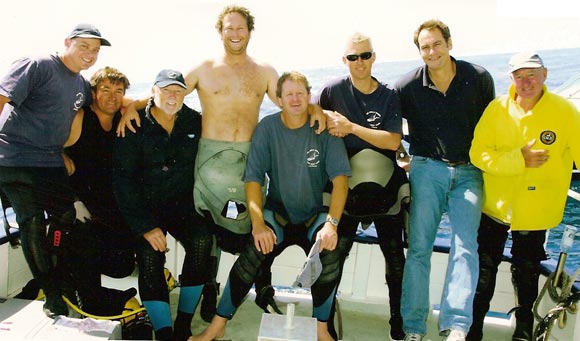 During the night of May 31, 1942 three Japanese Type A Midget Submarines entered Sydney Harbor in a darring attack. Two were salvaged after being sunk: M22 and M27, and were used on War Bond drives and are displayed at the Australian War Memorial and RAN Heritage Centre. The third sub, M24 remained a mystery since the war. Pacific Wrecks Interviews discovery team member Dave Arnold and their incredible discovery on November 12, 2006.
During the night of May 31, 1942 three Japanese Type A Midget Submarines entered Sydney Harbor in a darring attack. Two were salvaged after being sunk: M22 and M27, and were used on War Bond drives and are displayed at the Australian War Memorial and RAN Heritage Centre. The third sub, M24 remained a mystery since the war. Pacific Wrecks Interviews discovery team member Dave Arnold and their incredible discovery on November 12, 2006.
Tell about the team members
Phil Hendrie, Alan Simon, Tony Hay, Paul Baggott, Dave Muir, Greg Kearns, Dave Arnold are a group of seven regular guys who share a passion for diving and exploring. Our ages range from 32 to 65, which seems to only enhance our friendship and most weekends we can be found diving off the northern beaches of Sydney. We are known locally as the “no frills divers” and have 10 to 25 years diving experience between us. Our equipment is kept to a minimum and we dive most times to around 50 metres on single tanks on the wrecks off Sydney. Our interest in WWII began with overseas dive holidays to destinations such as P.N.G, Vanuatu, Solomon Islands and Philippines. Some of us had relatives who served during the war years. Our backgrounds vary a little, Phil and Alan are from a printing background (both retired), Tony is a bus driver, Dave, Paul and myself have trade backgrounds, builder, electrician and plumber and Greg is a mortgage broker.
Alan, Phil and Tony have known each other for over 20 years and the rest of us between 5 and 10 years. We met through local dive shops and introduced by others in the group. There are more “no frills divers”, but they now dive less frequently and were not with us the day we found the sub (now wishing they were).
How did the team get interested in the sub?
The interest in the midget sub story was stirred 12 months prior to our find, when another group who were confident they had located the M-24 further north of its now confirmed position made a documentary. This was proved to be another false claim along with at least 40 others over the last 64 years since May 31st 1942. To be honest we were not actively looking for the sub, we just got lucky that day!
Did prior false claims impact your discovery?
The false discovery claim 12 months prior, made the Australian Navy very skeptical. When our first footage was shown to them, questions were raised such as, “Is this an elaborate hoax? and which one of you built it in your back yard?” Even we laughed at the time and just let the video footage convince them that this time the mystery had at last been solved. They seem to believe us now, 100%! We don’t think others were looking for M-24 at the time but some are always working on their own theories about its location in the hope that one day it would be found as a result of that information.
Describe your search for the midget sub
Locating the sub was luck and search mixed together. Several months before, after diving another wreck north of the site, the fish finder was being used to scan the sea floor on the way back to the launching ramp. An anomaly showed up on the screen which at first was thought to be a small reef or at best a dumped barge as there are others in the same area which have been dived in the past. The anchor was thrown several times without success. The weather was deteriorating so the spot was stored on the G.P.S for another day.
Share what happened on the day of discovery
Sunday 12th November 2006 was a calm and clear day. Was this to be just another dive? Several months have passed before returning to the site, due to poor weather and other commitments getting in the way. The seven of us are all capable of diving the depth showing on the sounder [60 metres or 200 feet]. The anchor is thrown but does not hook again, eventually one finds the mark and holds.
Tony, Alan and Phil are the first in the water; several minutes pass and the rest of us are on our way. I recall a long cylinder or pipe coming into view and wonder why it is on the bottom out here? Maybe dumped! Then I notice a large trawler net towering above the three divers huddled on top of the pipe. What is this? Swimming to a tapering end the contra rotating props are found and only then do I realize that this is a sub, THE MISSING SUB!
The M-24 is sitting upright and half buried in the sand. The fishing net, which appears very old and is magnificent in its own right, has a thick soft coral growth on the upper parts ten metres above the hull. Some damage to the front of the sub has occurred, two metres seem to be gone, however, the two torpedo tubes are clearly visible and empty. The cowling around the conning tower has long since vanished and the guards around the props have also rusted away. The conning tower disguised by the aged trawler net was of much interest to the first three divers.
We meet up and communicate as best we can that we had found a sub. Phil drags me back to look at the props again, as if I need convincing a second time, maybe I did! Time was running out so we made our way to the anchor line and started for the surface. Fifteen minutes bottom time was the maximum with our limited air supply, and decompression stops would have to be made to avoid any risk of the bends when diving to that depth on air.
Back on the boats with the initial excitement and disbelief over we knew we had found the M-24. This was the third midget submarine that had attacked Sydney on the 31st May 1942 narrowly missing the USS Chicago before sinking the HMAS Kuttabul, killing 21 servicemen. Until now its fate remained unknown for 64 years. No other subs had been lost off Sydney. At this stage confidentiality would have to be kept. We still had more dives to make and extra footage required for the story to be completed over the remaining week.
Talk about the reports covering the discovery
The news of the find excited the media. We had kept the news of the discovery to the ‘need to know’ interests only, as it was somewhat of an “exclusive”. A leak did occur several days before the main event, but fortunately no harm done! We are all pleased with the end result.
The 60 minutes program was to air our story which included an interview with one of the survivors of the HMAS Kuttabul, along with all the details and parts of our under water video of the sub as we found it.
A popular women’s magazine also ran a follow-up story the next day, and the local paper had a field day with it for at least 7 days, other print filtered on. Networks and magazines are media linked and share information, deals are worked out which are beyond our control, arguments are settled by solicitors behind closed doors.
What has happened since the discovery?
We assume the remains of the Japanese crew of the M-24 are still inside and at this time are to be left undisturbed within a 500-metre protection zone. The authorities monitor the restricted area around the sub, incurring massive fines or imprisonment if breached or ignored and, even we, as the divers who found it are not permitted to go near it, however tempting.
We are confident for now it is safe from other divers who may not give the same respect that we have shown. The remaining relatives of sub Lieutenant Katsuhisa Ban and Petty Officer Mamoru Ashibe in Japan were notified of the find and we received a letter of thanks from the Japanese consul in Australia. The M-24 was provisionally declared an historic shipwreck on the 25th November 2006 under the Historic Shipwrecks Act of 1976.
What do you hope will be the future of the sub?
The team at first had hoped the wreck would be raised in the not too distant future, because if left will only vanish slowly to the elements of the sea or plundered and lost forever. We now know in other parts of the world it is usually agreed upon to leave these sites undisturbed when thought to be war graves. We also understand the cost involved to preserve such relics would be immense and, being so fragile after so long under water the task to move it would be colossal. We all feel very proud and honoured in solving the mystery surrounding the third midget submarine and in doing so, created a piece of history for ourselves!
What is next for the team?
What’s next ? The ‘no frills divers’ will carry on as normal enjoying regular weekend sorties and a beer at the local pub after the dives. The future may hold a different type of documentary about the M-24 if parties show interest in collaborating with us. As far as we know Australia is fresh out of subs just now,but you never know what you will find!
The HMAS Sydney lost off the west Australian coast at the end of 1941 also remains a mystery to this day. It is thought to be in very deep water well beyond even our limits (as much as we would like to help find it) we will leave that one to the experts!
Thank you Mr. Arnold and congratulations on the discovery!
Contribute
Information
Do you have photos or additional information to add?
